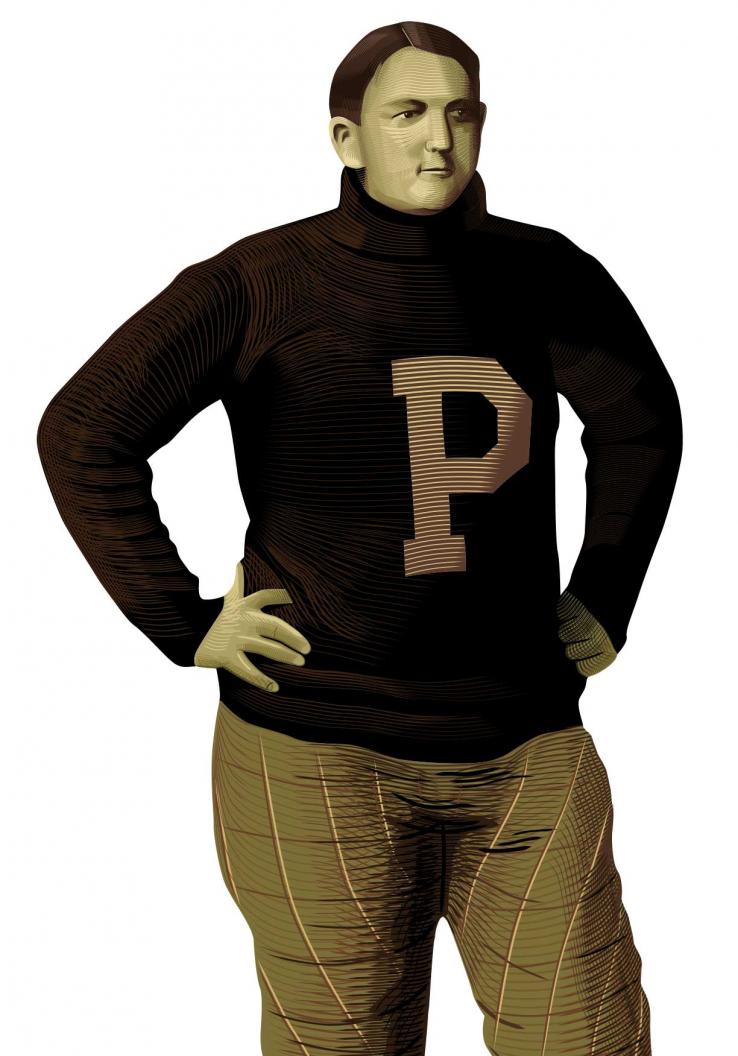
Ever since Princeton players competed in the very first game of intercollegiate football — against Rutgers, in 1869 — Princetonians have felt a certain ownership of the sport. Few took their passion to the lengths of William “Big Bill” Edwards 1900. Six feet tall, 225 pounds, a formidable presence in and out of a jersey, Edwards made it his lifelong mission to treat every day like a day on the football field — becoming one of Princeton’s legendary sportsmen.
In the 1890s, Princeton games were national events, with crowds from New York and beyond packing the stands. Alumni in the audience bounced and brawled; as they watched, many became boys again. Edwards recalled one man’s celebration after Harvard won a squeaker: “In the midst of the excitement, a Harvard graduate got up from his seat, climbed over the fence, put his derby hat and bulldog pipe on the grass, walked solemnly out a few paces, turned two complete handsprings, walked back, put on his hat, picked up his pipe, climbed solemnly over the fence again and took his place in the crowd. He was very businesslike about it and didn’t say a word. He had to get it out of his system — that was all. Nobody laughed at him.”
In Edwards’ junior year, his team unanimously voted him captain, a position he held for two years. He led Princeton to so many victories that, for decades after, the University invited him to headline alumni dinners and championship bonfires. As late as 1925, the Princetonian could name-check Edwards with confidence that readers would remember a student who had graduated a quarter-century before. A lighthearted article about the “golden nineties” quipped, “Princeton at that time contained some 250 odd students and three who were not odd. Those three clubbed together and later became Big Bill Edwards.”
After college, Edwards got into New York politics and returned, season after season, to coach Princeton’s team or referee games. In 1910, when a gunman shot Mayor William Gaynor, Edwards saved the mayor’s life by pinning the shooter in a tackle, preventing further injury. (He won a medal for bravery.)
He organized a national drive during World War I to send football uniforms to American soldiers in Europe, so they could play the game for recreation. In 1925, the city appointed Edwards to be the head of a new police academy for the NYPD. He modeled the training after — what else? — football. As The New York Times reported in a story headlined “Police to Have Course in Ethics of Football,” Edwards resolved that the city’s officers should learn the turf’s values of teamwork and fair play. “A man has to be game to be a member of the police department,” he said. “And it is my hope that they will bear in mind that their highest duty is ... to be on the level and to keep the police manual as their constant guide.” He borrowed his credo from Grantland Rice: “For when the one Great Scorer comes to write against your name, / He marks — not that you won or lost — but how you played the Game.”
Despite the fact that he worked in the Tammany government, despite the fact that his career included roles in waste management, revenue collections, and other dubious sectors in New York City, he appears to have been an honest dealer. Go figure. For what it’s worth, Princeton has provided a notable number of integrity czars, such as inspectors general, to the civil service. Maybe it’s the Honor Code. For Edwards, it was football.
“We are not dressed in football suits nowadays,” Edwards wrote in a 1916 memoir. “We are on the sidelines. We have a different part to play. Years have compelled a change. In spirit, however, we are still ‘in the game.’”
